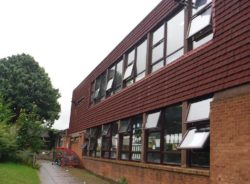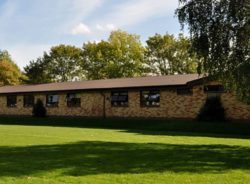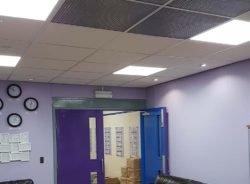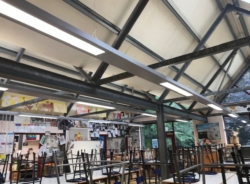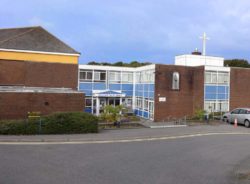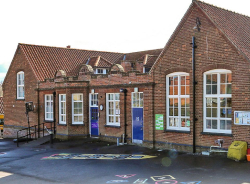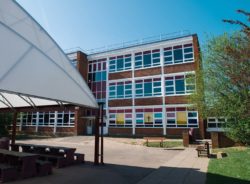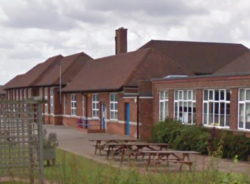How to Light Larger Spaces in a School
It’s Complicated
Lighting larger spaces in schools is a complex task and requires careful attention to ensure all needs are met.
The complexity stems from the fact that the larger areas such as assembly halls, sports halls, theatres and atriums, are frequently used for a number of different activities, occasionally at the same time.
The Key Aim
And the overriding aim, as always with lighting in education, is to ensure that pupils and staff can carry out activities easily and comfortably in pleasing, stimulating settings.
Government advice on lighting in “Standards for School Premises” highlights a range of areas that need to be kept in mind when focusing on illuminating these larger spaces.
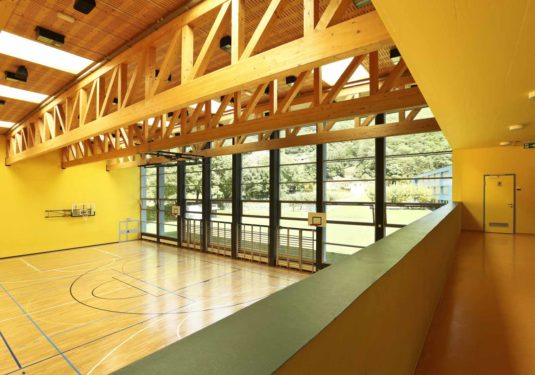

The “checklist” includes:
- Adequate lighting levels for good visual communication
- Making daylight a priority
- Views to the outside or distance for visual comfort
- Lighting controls
- Control of daylight and sunlight
Sports Halls
For sports halls and gyms, the lighting requirements can vary according to the activity. For example, the smaller and faster the ball is, the more light is needed but in general, the recommended level of light, in line with British and European Standard 12464-1, is 300 lux.
Uniform illumination is always the goal and linear luminaires in a continuous line can provide this even light. And provision of a smart lighting management system will help to provide the flexibility needed.
At the same time the lighting should be able to cover the most demanding activity. Sports halls are often used for exams which more brightness – 500 lux – as well as evening events that need lower levels.
When the sports hall has partition walls for a range of sports in different zones, effective lighting controls will ensure that the right light is delivered to these areas.
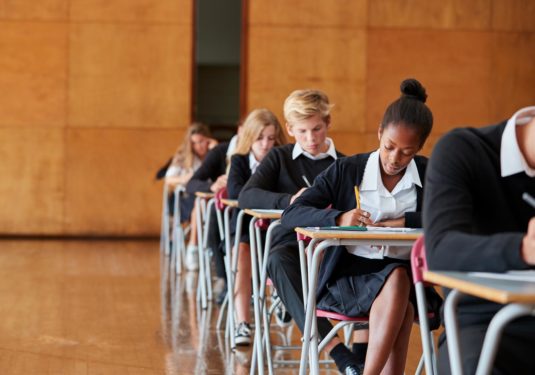

Glare-free
Glare-free light is important as during training and competition the players need to look up without being dazzled.
While daylight is beneficial in sports halls and gym, this needs to be intelligently managed as glare can cause discomfort to users who are often moving quickly and looking up frequently. Reflected glare from shiny floors and other surfaces can cause problems and so screening facilities should be in place to control this source of light.
Ideally, luminaires with both upward and downward light should be in place with controls that minimise any glare while providing effective light distribution on vertical surfaces.
High Lights, Low Costs
The high positioning of luminaires in sports halls and gyms adds to the complexity of maintenance and this is one reason for selecting products with long working life, like LEDs. These can provide up to 50,000 hours of maintenance-free use, with effective quality of light throughout the life cycle.
It also crucial that all luminaires in sports halls should be impact resistant and compliance with the ball test in DIN 57710 part 13 is recommended. Luminaires and lamps should have wire guards or other impact-resistant protection.
As the amount of light often is high, energy consumption should be reduced to a minimum when the hall is not being used and presence detection sensors are a good way of achieving this. Energy savings of 25-30% can be achieved with occupancy sensors.
Different activities
The larger spaces in schools will very often be used for a range of different activities and the lighting should cater for all these.
A blackout facility should be available and the provision of luminaires that provide both upward and downward light would be a minimum requirement in these multiple-use areas, with provision to switch luminaires in groups for some flexibility.
In halls that are also used for concerts, theatrical and dance productions, there would be a need for an adaptable stage lighting system to ensure that the various events are optimally lit. Wiring systems should also be designed to allow for additional lighting equipment when needed.
Lighting barrels will need to be placed above and in front of a stage, utilising both wall-mounted brackets and lighting sockets. High level, wall mounted and stage sockets should all be wired back to a dimmer panel on one side of the stage.
In drama studios, general mood lighting across the whole studio is needed as well as full theatre lighting and this requires the provision of lighting points across the space to place lights in any part of the room.
One effective solution is to have a series of pre-wired lighting barrels at intervals across the width of the room with the lighting sockets wired back to a dimmer panel and 18-way control desk.
Intelligent lighting controls help to make sure that illumination of larger spaces in schools is effectively managed, including agile response to changes in daylight levels. But at the very least, it’s wise to consider the provision of dimming circuits and to check that lamps can be dimmed.
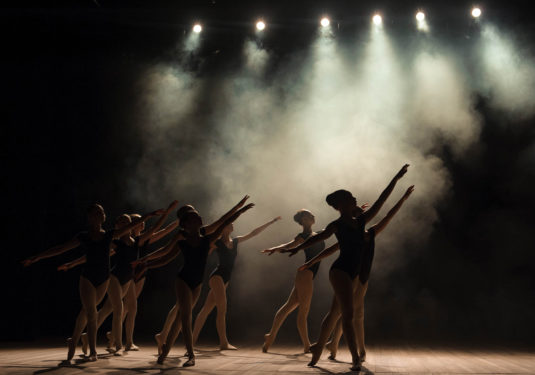

In drama studios, general mood lighting across the whole studio is needed as well as full theatre lighting and this requires the provision of lighting points across the space to place lights in any part of the room.
One effective solution is to have a series of pre-wired lighting barrels at intervals across the width of the room with the lighting sockets wired back to a dimmer panel and 18-way control desk.
Intelligent lighting controls help to make sure that illumination of larger spaces in schools is effectively managed, including agile response to changes in daylight levels. But at the very least, it’s wise to consider the provision of dimming circuits and to check that lamps can be dimmed.


